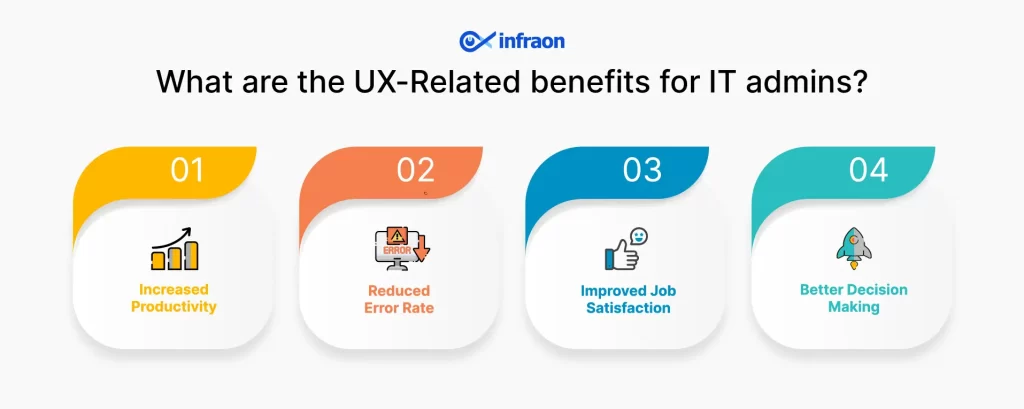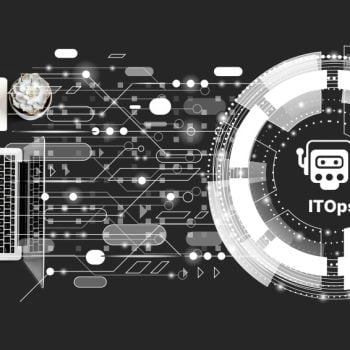Traditionally, IT administrators have been the backbone of business technology, managing everything from server setups to network security. As technology advances, so do the tools and systems that IT administrators must use and manage.
The integration of more advanced systems management tools requires administrators to adapt to new workflows and interfaces. Improved user experience (UX) in these tools is crucial for allowing IT admins to manage their responsibilities with greater ease and satisfaction.
Also, in an era where technology is at the heart of business operations, UX can be a proverbial game-changer.
Related blog: Designing Seamless Enterprise User Experiences: Unlock the Power of UI/UX in SaaS
The importance of User Experience for IT admins
UX or User Experience refers to the overall experience a person has while using a software, especially regarding how convenient is to use. For IT administrators, the software and tools essential for their daily tasks often suffer from complex interfaces and inefficient workflows, which can lead to errors and decreased productivity. By enhancing UX, these tools can become more intuitive, which in turn boosts productivity and reduces the likelihood of mistakes.
For instance, a simplified dashboard that allows admins to monitor network health, security alerts, and system performance from a single interface can dramatically increase operational speed. Integrating smart notifications that prioritize alerts based on urgency and relevance can help admins focus on critical issues first, improving overall system management.
Also, the tools used by IT administrators are not isolated systems; they are integral to the broader set of business applications. Hence, proper UX can influence the productivity and satisfaction of other business users.
Improved interfaces and workflows in IT administration can lead to more rapid responses to tech issues faced by business users, resulting in less downtime and higher productivity across departments.
Unfortunately, the fact remains that even in 2024 – IT administrators often face several UX challenges.
Common UX challenges faced by IT admins
Organizations can adopt several strategies to enhance UX for IT admin tools. These include:
- Complex user interfaces: Many IT admin tools have complex user interfaces loaded with technical features and settings. This complexity can make the tools difficult to navigate and use, especially for new or less technical users, leading to increased time spent on tasks and potential errors.
- Overwhelming amount of alerts: IT admin tools often generate a high volume of alerts and notifications. It can result in information overload, where critical alerts may get lost in the noise, potentially causing delayed responses to important issues.
- Lack of integration: IT environments typically involve multiple tools and platforms. A common challenge is the lack of integration among these tools, requiring IT admins to switch between multiple systems to gather information or perform tasks, which is error-prone.
- Inflexible workflows: Many IT admin tools come with predefined workflows that may not align well with the specific processes of an organization. This inflexibility can limit the ability of IT admins to adapt the tools to preferred workflows, reducing overall productivity.
- Poor mobile experience: As remote work continues to rise, IT admins increasingly need to manage systems from various locations and devices. However, many IT admin tools still lack a robust mobile interface, making remote management cumbersome.
How to implement UX improvements
Ensuring good user experiences for IT administration tools is crucial to boosting productivity and job satisfaction. Here are seven strategies to help:
- User-centric design: Start the design process by understanding the needs, workflows, and pain points of IT admins. It can be achieved through surveys, interviews, and shadowing sessions. Designing with the end-user in mind ensures that the tools are intuitive.
- Simplified interfaces/consoles: Reduce complexity by designing clear and simple user interfaces. Organize information logically and minimize the number of steps required to perform common tasks. A clean, straightforward interface helps reduce cognitive load and speeds up task completion.
- Deep customization: Allow IT admins to customize aspects of their interface and workflows. It includes setting up personalized dashboards, choosing which notifications to receive, and configuring workflows that match their operational style and the organization’s procedures.
- Seamless integration: Enable better integration with other tools and platforms used within the IT environment. It can reduce the need to switch between different systems and allow for a more streamlined and cohesive working experience.
- User feedback loop: Develop a thorough feedback loop with IT admins to regularly gather insights on their experiences with the tools. Use this feedback to make iterative improvements and updates, ensuring the tools evolve with the users’ needs and the latest technological advancements.
- Training and support: Provide comprehensive training and ready access to support resources to help IT admins understand and utilize the full capabilities of the tools. Adequate training can reduce the learning curve and improve productivity, while ongoing support ensures IT admins can quickly resolve issues with the tool.
What are the UX-related benefits for IT admins?

Increased productivity
Good UX simplifies the use of IT tools and systems, reducing the time IT admins spend navigating complex interfaces or cumbersome workflows. With intuitive designs and streamlined processes, IT admins can perform their tasks more quickly and with fewer errors, allowing them to manage more systems or to spend more time on strategic initiatives.
Reduced error rate
A well-designed user interface that aligns with common IT tasks and workflows helps minimize mistakes. Clear visual cues, consistent navigation, and simplified processes reduce the likelihood of operational errors, which are crucial in high-stakes IT environments where mistakes can lead to significant disruptions.
Improved job satisfaction
When IT admin tools are user-friendly, they lead to less frustration and a more satisfying work experience. Better UX can help retain top IT talent by making their roles more enjoyable and less stressful. It is important in high-pressure IT environments where job satisfaction can directly influence employee retention.
Better decision-making
The right UX in IT tools often includes better data presentation and management features, such as dashboards that provide at-a-glance insights into system performance, security threats, and other critical metrics. It allows IT admins to make informed decisions quickly, improving their ability to respond to issues proactively and plan for future needs.
Related blog: Stress-free IT management: An IT manager’s playbook for mitigating risks



















